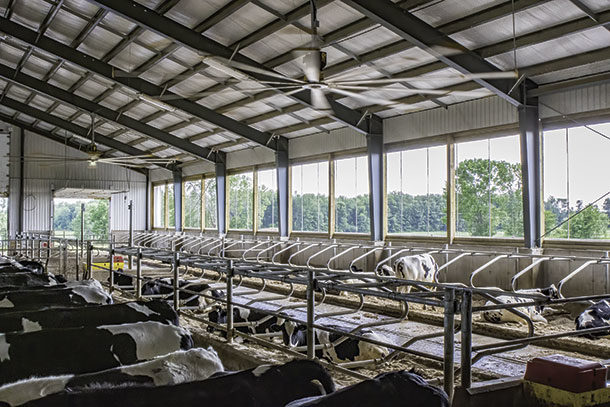Not too long ago, we relied heavily upon natural ventilation for adult dairy cattle facilities, but in recent years a variety of mechanical and hybrid options have emerged that have the potential to improve ventilation performance.
However, these systems come with a cost, and it is clear that each has relative strengths and weaknesses given the circumstances in which they are used. That is why we use a set of criteria to evaluate the relative merits of a particular system. These are:
- The provision of target air speed in the cow’s resting area microenvironment – fast-moving air when it is hot and a gentle breeze when it is cold
- Sufficient exhaust of the heat, moisture, dust and noxious gases from the barn at an adequate rate year-round
- Ability to function well across all seasons – particularly in variable climates
- Cost-effectiveness – Do the benefits of the system over and above natural ventilation offset the increased costs?
Since barns can be designed with multiple ventilation options that meet these criteria, we recommend estimating the installation and operating costs of any given barn with different systems for the location. The final choice will depend upon how well the system meets the aforementioned criteria, the climate where the barn is situated, the size and floor plan of the facility, certain management considerations that may be unique to the farm’s situation, barn aesthetics, producer comfort with fan maintenance requirements and, of course, economics.
We have created a design spreadsheet tool for use in The Dairyland Initiative workshops that estimates the operating costs for each type of ventilation system and, as a routine, we calculate the running costs for the following seven operating systems:
- Natural ventilation with fans over the stalls
- Positive-pressure hybrid ventilation – with fans pushing air into the barn along each sidewall
- Tunnel-hybrid ventilation with cupola fans and curtains for cold-weather ventilation and tunnel ventilation for hot weather
- Tunnel ventilation with fans above the stalls for year-round operation
- Cross-ventilation with fans over the stalls
- Cross-ventilation with baffles over the stalls
- “Big box” cross-ventilation with a flat ceiling
There are subtle variations of these seven basic concepts but, in general, these options would cover more than 90% of the operating systems we see in the field. Dr. Mario Mondaca built the operating cost estimate in the spreadsheet based upon climate data from each region so that different fan options for each scenario can be explored. Fan choice can impact cost of operation considerably, so particular attention should be paid to fan test data including the ventilation efficiency ratio and air flow ratio – which tell us how efficient and how effective the fan can be.
The cost of installation and operation can be compared with an estimate of the cost of heat stress in any given location in the U.S. using data collected in 2003. While that estimate is likely an underestimate of the true current costs of heat stress when cow health and other effects are considered, it is a starting point for a discussion of the relative merits of a system. Currently, there is no way to account for the economics of winter ventilation and improvements in air quality that may impact the rates of pneumonia. These losses are likely trivial compared to heat stress loss, but they should be considered in variable climates where the performance of the system in cold weather is critical.
Table 1 below was constructed for building an 800-cow facility in Green Bay, Wisconsin, using the seven different ventilation options described above, using layouts with either one or two drive-through feed lanes to best suit the design and a limited fan choice.

The estimates are for that scenario only and should not be applied elsewhere. We typically see operating costs at least double the magnitude presented here for hot climates year-round. The estimated marginal milk loss due to the cost of heat stress for cows in Green Bay is $74 per cow per year, and the cost of operating each system was $20 to $61 per cow per year – making any of these systems a viable option to consider in this location.
Natural ventilation remains a low-cost alternative for barns that can be built free from wind shadows and correctly oriented to capture available winds. However, when the site is compromised, other alternatives are available. The positive-pressure hybrid has a low cost of operation and likely meets the design criteria for a varied climate when limited to a four-row barn with a traditional center feedlane, but the cost of installation is high and the number of fans fourfold higher than a cross-ventilation design with baffles, creating fan maintenance concerns.
Cross-ventilation designs can be built with baffles over stalls, fans over stalls or as a big box design with a low and flat internal ceiling. The baffle design is the most common and the lowest-cost to operate. It is also well suited to the use of evaporative cooling in low humidity conditions. In hot climates, they can actually be an equivalent cost to run compared to a natural ventilation option – since they run near maximum all the time and they use fans very efficiently.
The issues of baffles trapping air within the barn during cold weather at lower exhaust rates can be reduced by using retractable curtain baffles rather than solid metal, but some barns still struggle when built too wide. Those who opt to use fans rather than baffles must justify the extra cost of installation and operation – which are identical to an equivalent year-round tunnel design with fans over the stalls. The big box system comes in with an operating and installation cost between the cross with baffles and cross with stall fans and is more viable in hotter climates since it struggles to provide effective cold-weather ventilation at low exhaust rates, especially when built with more than approximately 12 rows of stalls.
The year-round tunnel option with fans over the stalls provides highly effective exhaust in the summer and target air speed in the resting area, but it faces challenges in cold weather at low ventilation rates. Tunnel barns are somewhat limited in length of the floor plan, since air quality tends to deteriorate in barns longer than approximately 500 feet. While these barns are at the higher end of cost of installation and operation, there are cost savings related to sidewall construction where walls may be made of cheaper polycarbonate rather than more expensive curtains.
The tunnel hybrid comes in at the high end of cost for installation and operation, but it also provides great flexibility. This barn can switch between tunnel ventilation in hot weather and a mechanically assisted natural ventilation concept in cold weather with cupola fans in the ridge assisting the movement of air out of the barn. This advantage is useful in varied climates but unnecessary in regions where it is hot all the time. Higher costs relate to the use of the cupola fans and the need for at least a partial curtain sidewall so as to provide a winter inlet system. However, this is the only mechanical ventilation option that facilitates letting cows outside some of the time, which may be important in certain milk markets.
This ventilation cost comparison exercise allows for an informed discussion between the dairy producer and their consultants, and the choice of the optimal system to suit their needs and situation.
More information about ventilating adult cow barns can be found at Dairyland Initiative.






